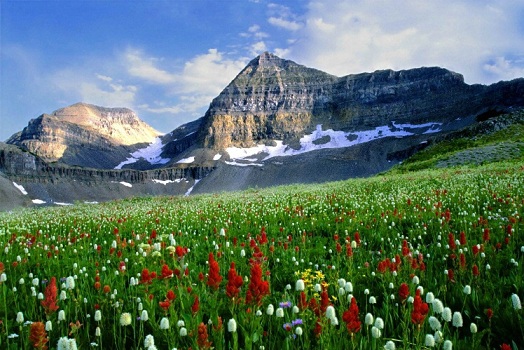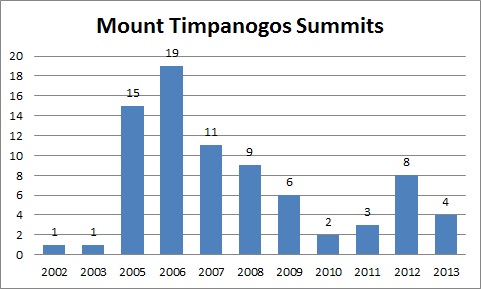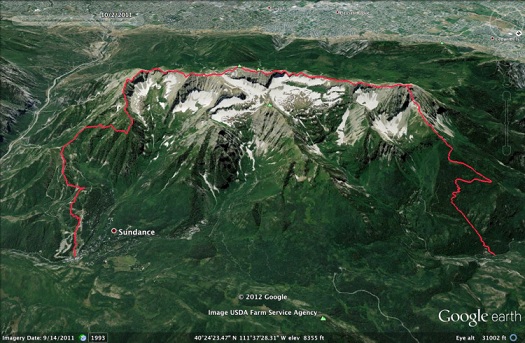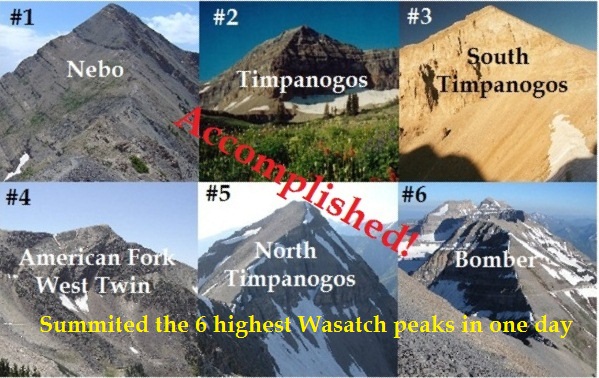
Because of its impact on my running development, I must include an entire chapter on Mount Timpanogos (locally in Utah referred to as “Timp”). For more than 100 years, Mount Timpanogos (11,749 feet) has been the most popular hiking destination in Utah. Timp towers over the valley floors below by more than 7,000 feet – an impressive sight that draws hikers of all ages to its trails. A single round trip to the summit on the trail covers about 14 miles and climbs almost 4,700 feet. (Compare this to about 4,460 feet elevation change hiking down into the Grand Canyon from the South Rim (Bright Angel trail) and back with about the same mileage).

Two trails are the most common accesses to the summit, Timpooneke Trail (from American Fork Canyon) and Mount Timpanogos Trail near Aspen Grove (from Provo Canyon). I prefer the Timpooneke Trail because of its steady, runnable ascent. The trail ascends through a large valley, climbing through a series of four major plateaus, collectively known as the Giant Staircase. You travel by impressive waterfalls, forests, and meadows with wildflowers. Deer and moose are commonly seen along the way.

The final step in the staircase is the Timpanogos Basin (elevation 10,100 feet), a wide-open plateau, surrounded by mountains on three sides. From this basin it is about two miles to the summit. You first climb up to a saddle that presents a view of Utah Valley to the west. Lastly, you make a rough, rocky climb that is steep at times up to the summit.

The trail is mostly runnable, but pretty technical. There are only short sections where the trail is smooth. Most of the trail has large rocks imbedded in it and some rock-slide sections have loose rock. The final steep climb to the summit has many loose rocks. Running quickly down the trail requires intense concentration. I enjoy the trail because it is so technical.
In 2002, I made my first ascent up Timp. It was a slow ten-hour adventure that wore me out. I was physically drained and felt sick and sore for two days. Eight to ten hours or more is typical hiking time for this strenuous hike. Now, a typical trip for me (without racing it) takes about four hours, 2:20 up and 1:40 down with no stops. My fastest round-trip time has been 3:10. I rarely try to race it because I realize that if I do, it will involve one or two falls because of the technical nature of the trail and also because of the distraction of having many hikers also on the trail. During my 3:10 trip, I was on schedule to break three hours, but I fell twice, pretty badly, and those falls took the wind out of my sails. The fastest known time to the top was 1:15:36 by Danny Moody.
As I was developing as an ultrarunner, my mentor, Phil Lowry, introduced to me using the Timp trail for training and to keep track of career summits. Previously I had started to run up and down the mountain but would not do it right, stopping at a saddle, skipping the rugged climb to the summit. Phil helped me understand that reaching the summit each time is what it is all about. As I concentrated on regular trips up the mountain my hill climbing strength increased and it improved my altitude acclimatization. My confidence and ability on to run technical trails was improved.

During 2006, Phil was in a duel with Ben Woolsey for #1 in career Timp summits. Phil passed Ben, and by 2007 Phil had about 360 summits to Ben’s 340. But Ben is a retired postman from Orem, Utah and once Phil moved further north, and later served in Afghanistan, Ben continued on.

As of 2014, Phil has more than 400 summits, but in 2013 Ben reached 600 career summits, an astonishing achievement, probably about 4,000 hours on that mountain. In 2014 you can now find Ben on most days doing repeats going up to the block “Y” above Provo.
By 2013, I had been on the Timp summit 79 times. Surprisingly about 60 of the summits were accomplished at night, in the dark. Traditionally, many college students start their hike very early in the morning in order to reach the summit by sunrise. I really enjoy running up the trail at night because I can chase these lights on the mountain. It is a great game. But also, since I do much of my training during the early morning, it is a perfect match because I know the trail so well, every turn, and so many of the rocks. The groups of hikers can see me coming, sometimes getting scared seeing my green light zoom up the mountain. Once, I had a red headlamp and was also holding my green light. A group tracked my swift progress and when I reached them, they were pretty terrified. They admitted that they thought I was an alien.
When I run down, usually in the dawn light, I often get asked by these young hikers why I’m running down so fast, if something is wrong. My favorite answer is, “She’s going to blow! The mountain is going to blow!” (Timp is NOT a volcano). I chuckle as I keep running seeing the wide-eyed response of the college kids. Passing all these youngsters is good for the ego. Comments always include something like, “you are a freaking animal,” or “you are my hero!” My response sometimes is, “I’m just an old man out for a morning stroll.”

As my ultrarunning experience increased, and I started to become more competitive in races, I shifted to do smarter training to increase my speed. Running up and down Timp was great for increasing climbing strength and for altitude training, but it didn’t enhance my foot speed. It is a difficult trail to run down with great speed. I discovered as I added more tempo runs and some speed work into my training, that my overall performance dramatically increased in 2009-2010.
My personal emphasis in climbing Mount Timpanogos has not been to achieve career summits. But I have caused a stir with my Timp repeats.
The Double Timpanogos
I remember in 2003 observing a guy running the trail for the first time and I was very surprised to notice that he ran the trail twice! He only went to the saddle and back twice, but still, I was impressed. Accomplishing a double Timpanogos hike is a significant physical and mental challenge. To achieve this feat, you do the hike twice in one day with a very short rest at the trailhead between trips to eat and drink. The nearly 9,400-foot climb and 9,400 decent in about 28 miles is a grueling physical challenge, but the mental aspect is just as challenging. After finishing an exhausting single hike/run, you must turn right around and make yourself repeat the same physical challenge again.
I have accomplished the double Timp on quite a few occasions. During such a deed, I would pass other hikers as many as 3-4 times. When they finally realize that they have seen you pass them multiple times, they insist on knowing what is going on. Reactions are amusing. People are flabbergasted at the thought of hiking it twice, not to mention seeing you run many portions of the trail. On my first double experience several hiking groups cheered me as I descended for the second time. I remember one group started a chant, “Go for 3, go for 3.”
The Triple Timpanogos
I was the first person to accomplish a triple Timp. There have been three others who have accomplished a triple. Phil Lowry, Dallan Manscill, and Brent Rutledge. Read my Triple adventures: June 29-30, 2005, October 14-15, 2007.
The Quad Timpanogos
On June 30, 2006, I had planned to run another triple Timpanogos, but on the way down from my third trip, I met my mentor, Phil Lowry in the basin. He planned to match my triple accomplishment the following Monday. I said, “I should continue and do a quad today just to spite you!” He replied, “I bet you can’t do it. You will get to the bottom with sore legs and call it quits. I dare you to try.” I smiled, knowing that he threw down a challenge I couldn’t resist. He had left a note on my car that said, “We are all freaks, and you are our KING! You are nuts, Phil.” I headed back up. Despite my slow pace, I was still going faster than all the hikers. At the top, local ultrarunner pioneer, Grizz Randall congratulated me. I did it! I accomplished the first quad Timpanogos. My four trips took a total of 22 hours. You can read the details here.
That Monday, Phil Lowry attempted to match my quad. He allocated 17 hours for the feat and was pretty much on schedule, but called it quits after triple. He was the second person to accomplish a triple. A few weeks later, Dallan Manscill matched my quad, doing it as supported run.
The Quint Timpanogos
Since Dallan had matched my quad Timp, I was asked many times if I was going to go for five. Yes, I was determined, but fully knew how difficult it would be with nearly 24,000 feet of climbing. I went to face the challenge on August 18, 2006. It would be a busy time on the mountain and many friends would witness my nutty accomplishment. As I passed people, many asked me the usual questions. I tried to explain that I was trying to break my record of four summits and do five consecutive summits. One guy asked me, “What kind of record is that, a record for the criminally insane?” During my fifth trip, word traveled up and down among the hikers what I was doing. I stopped to talk to many groups who were very encouraging and cheered me on. I arrived to the top for the fifth time without fanfare, just quietly went into the hut and signed the register. When I returned to the trailhead, a forest service guy was there and said, “There he is, the 5-summit guy!” My total time ended up being 27:24:36. Read the details here.
As of 2014, I am still the only person to accomplish a quint Timpanogos. Three times since then, I went up the with the hopes to do six, but each time I only did two or three and came home vowing that I’ll never try again to break it, that it is just too stupid and hard. Others have their eye on it. In 2013, Jennilyn Eaton attempted to break it but was turned away by bad weather before her third summit. This may be a record that will last through the ages.
While it may seem that these repeat trips are pretty insane, they actually trained me to be very mentally tough, to continue when everything screamed at me to stop. This helped me later on to have the mental toughness to avoid DNFs, to continue on loop format courses, and have the mental toughness for fixed-time races. I also became the first person to run a double Kings Peak, the highest peak in Utah. A double involves about 52 miles. As of 2014 I still am the only person to do that and have accomplished it three times.
Running the Timp Ridge

In 2013, I tried something new for me on Timpanogos, to run the entire Timpanogos ridge, summiting all the peaks along the way. In 2012, Jared Campbell accomplished this amazing feat doing both the climb and descent using routes, not trails. (See route above).

I wasn’t as daring, and instead chose to use the established trail to reach the top in the middle and then do out-and-backs to both ends of the ridge, essentially running it twice.

The first time I did this, I ran it during the night and in the fog! It was a crazy adventure and you can read the details here. A week later I repeated it because I was trying to summit the six highest Wasatch peaks in one day. I did accomplish this crazy feat. (Actually it was the five highest peaks using a 300-foot prominence definition. Bomber Peak misses that definition by a few feet). Read the details of that adventure here.
Including all my runs on the mountain, I’ve probably run about 1,800 miles on Timp.
In those early years 2004-2006, practically the only runners that could be seen on the mountain were Phil and I, but today from June to October you can see many runners every weekend making their way up and down the mountain. In June there is usually still large snow fields to cross and the entire Basin may be covered making the ascent slower, but if you know the right early season routes, you can get down the mountain very fast. It is best to learn the trail well, going up first with someone experienced. I’ve seen so many first-timers taking some wrong turns and get in trouble, especially in the early season. Be careful up there.


Lots of good memories on the mountain! I would agree with you that multiple summits in one day helps with mental toughness. The reason I was able to finish a 100 miler was because of my multiple summit training.